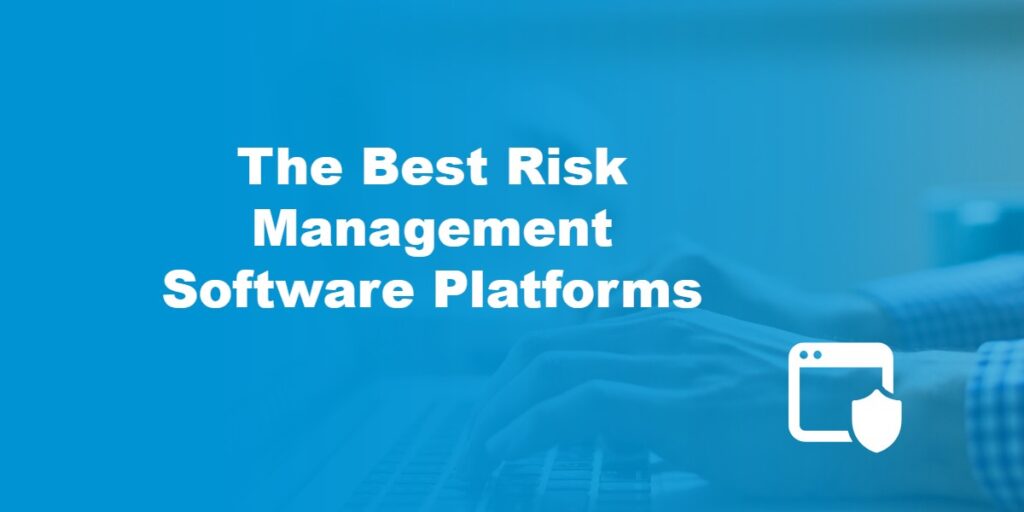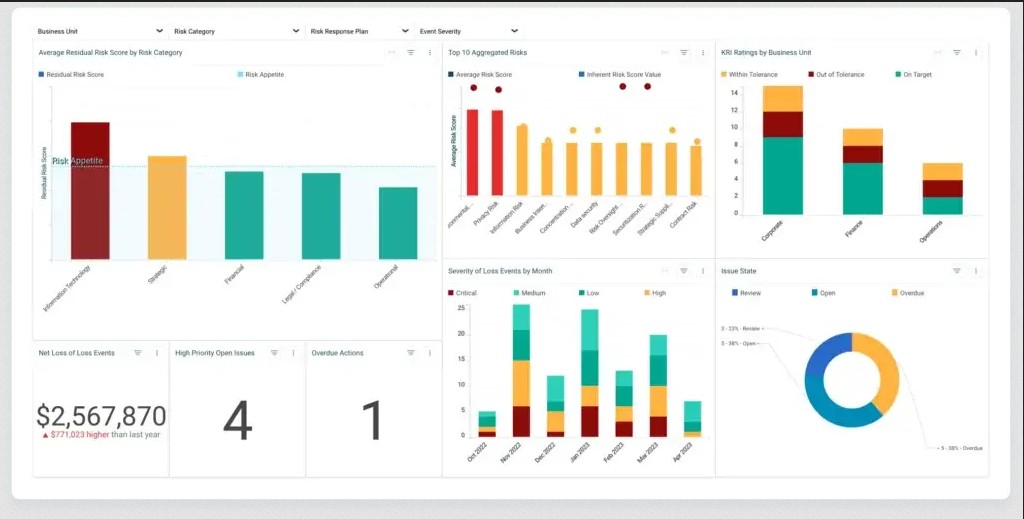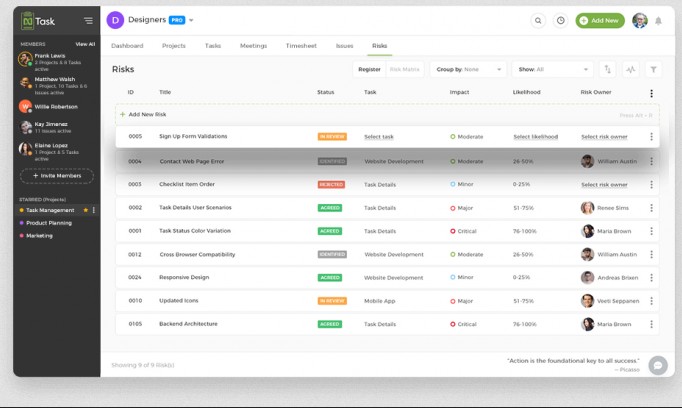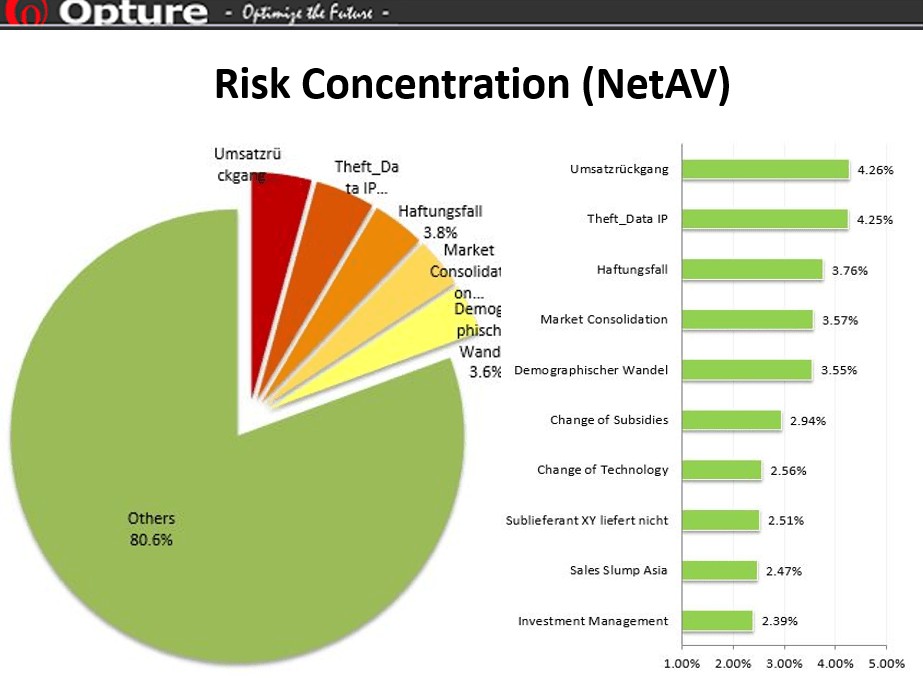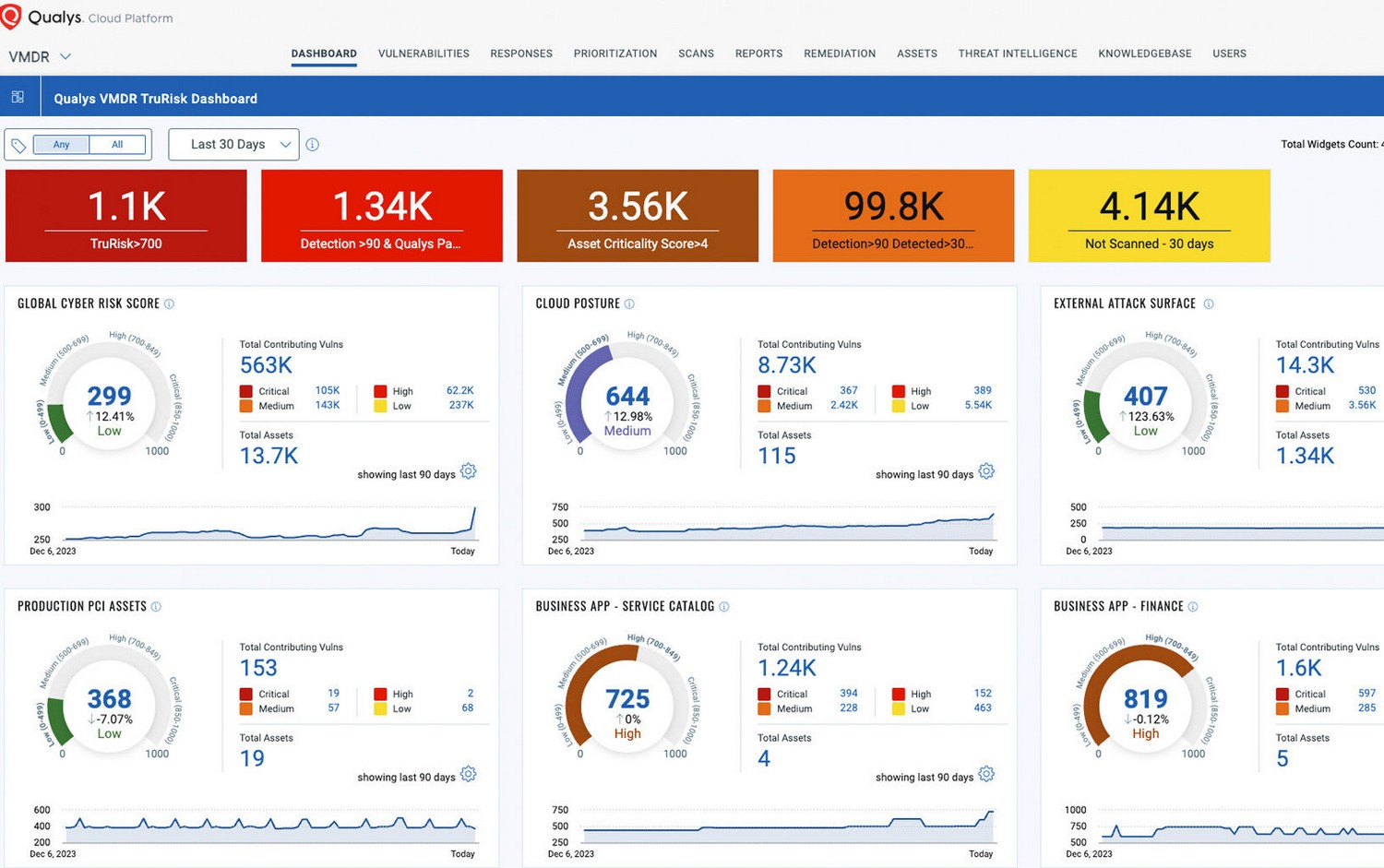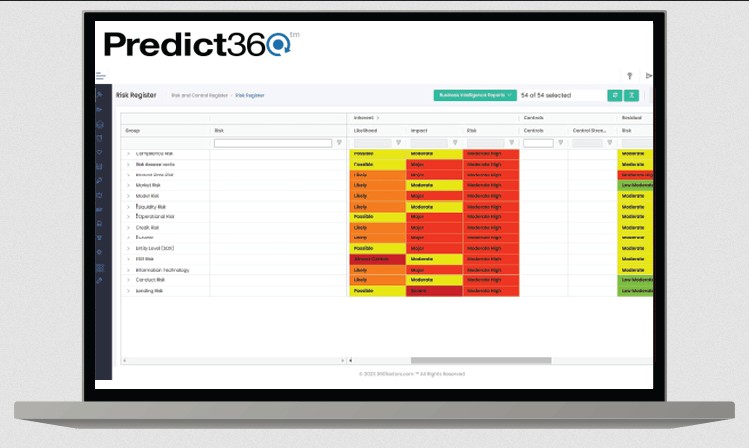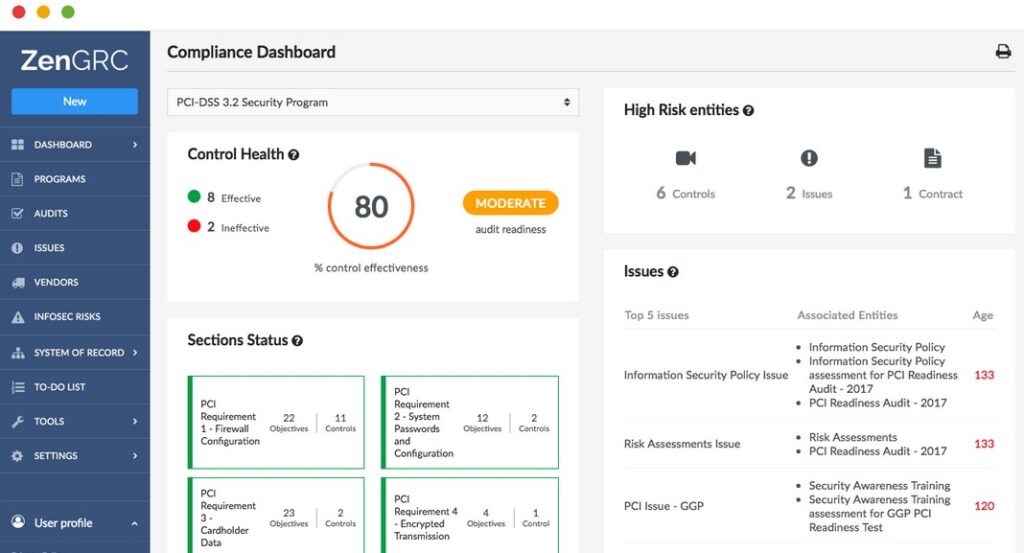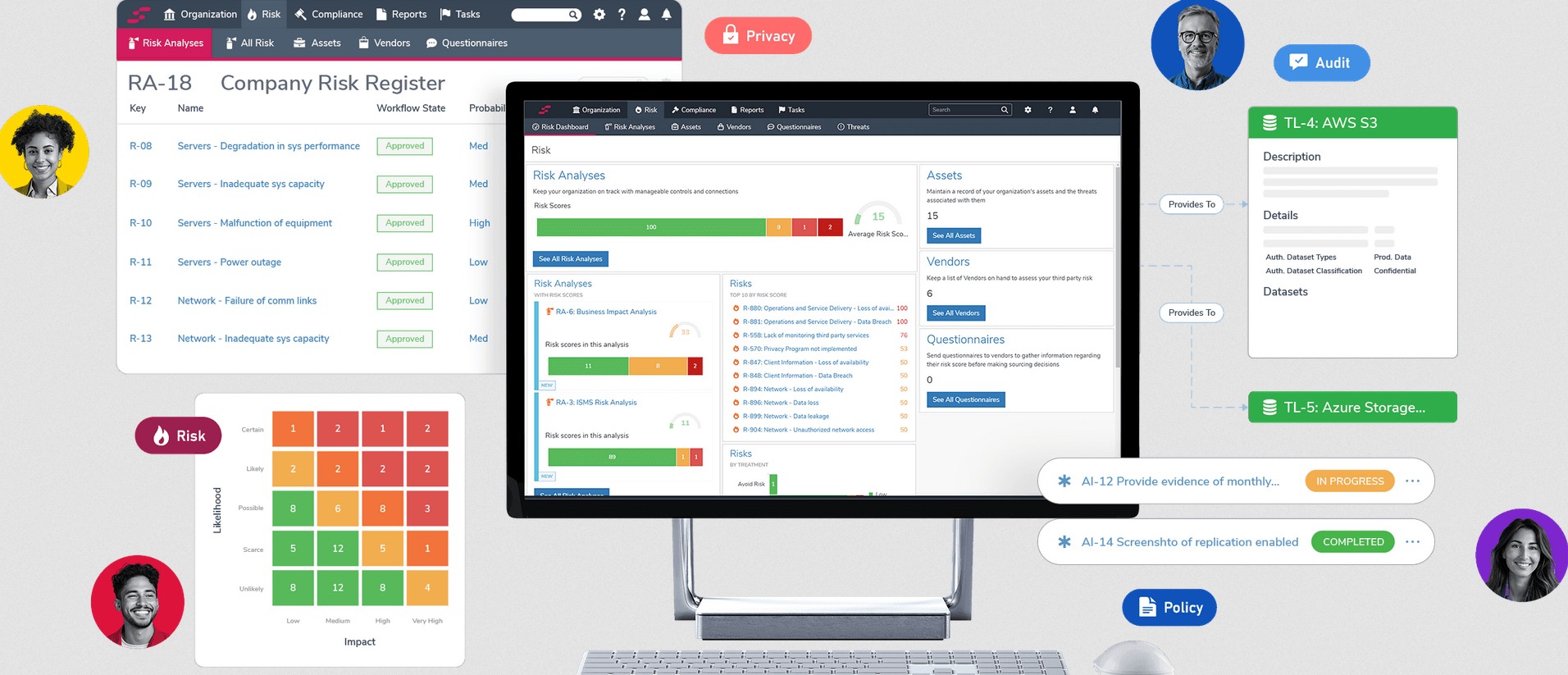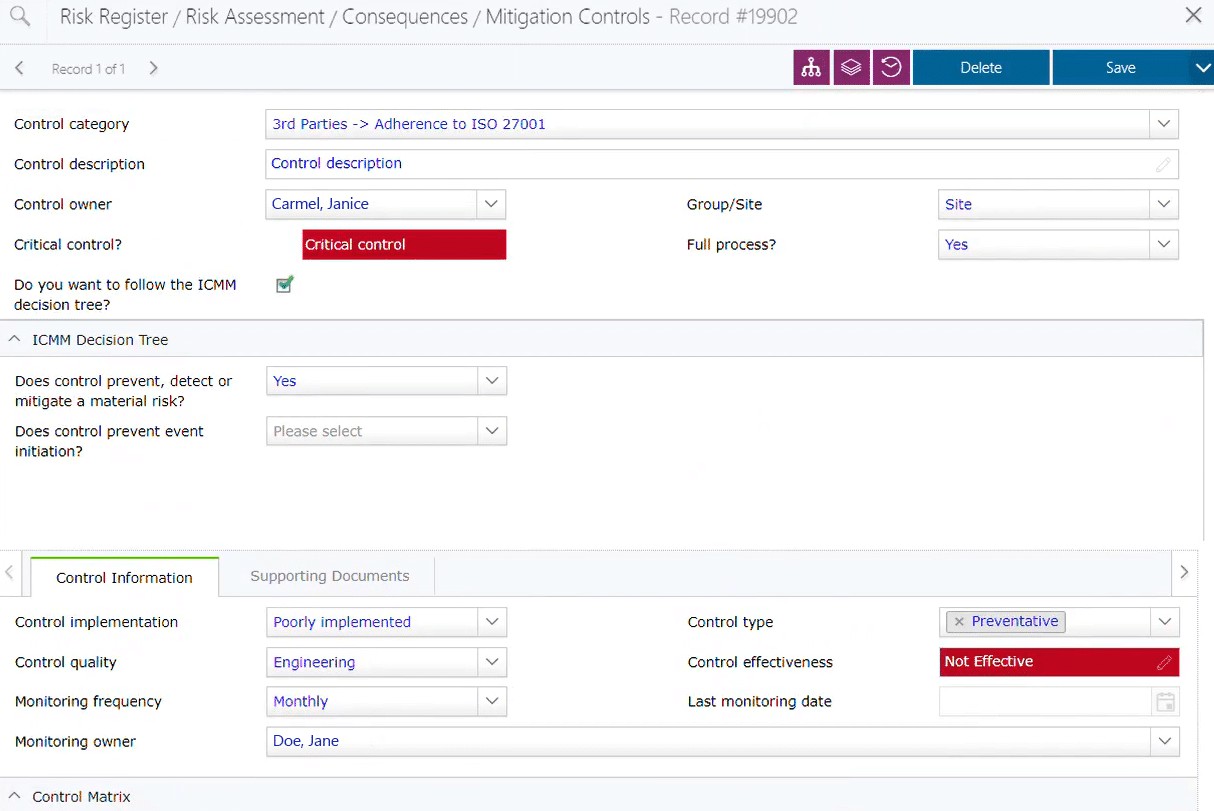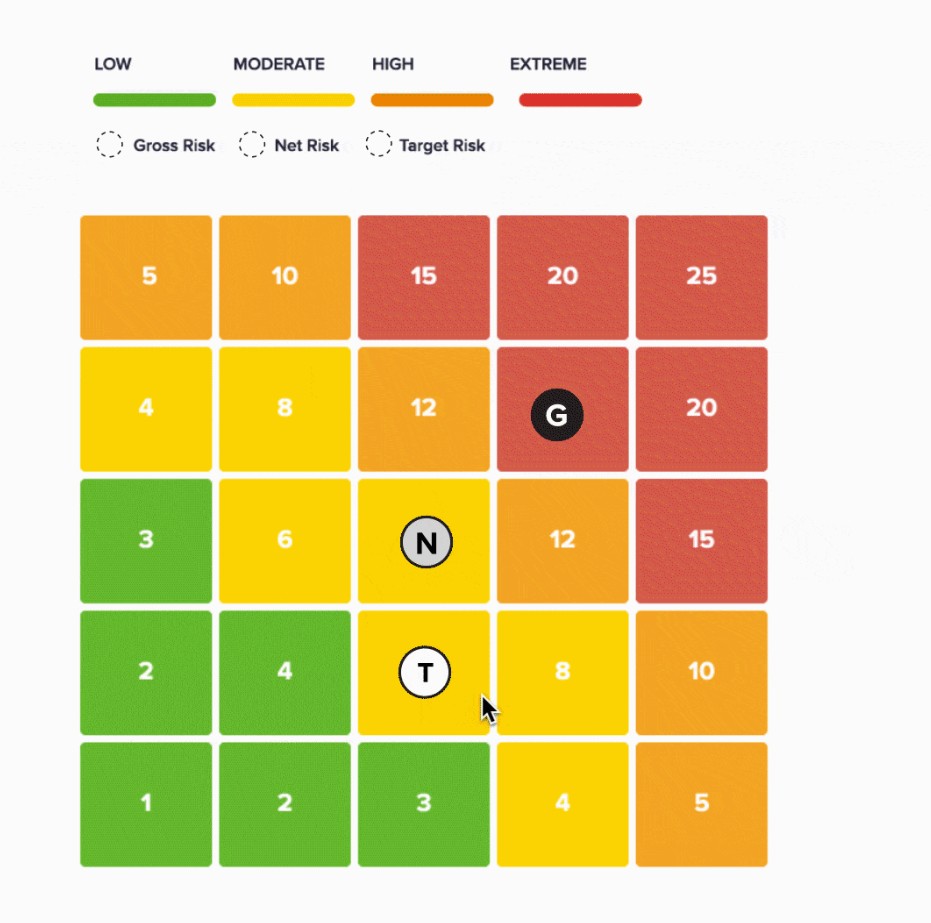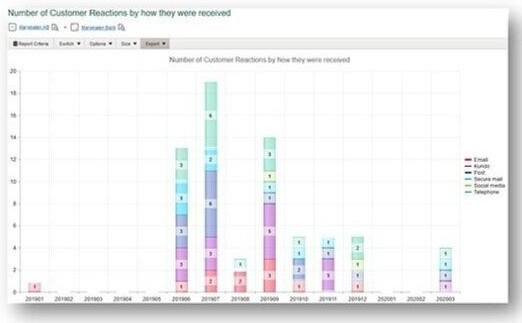Risks are events and factors that bring down the profits of a business. They are an inherent part of every business and can take many forms – strategic, operational, security, compliance, legal, technology, financial, and more. To counter the impact of these risks, organizations must follow a streamlined process of identifying, assessing, controlling, and remediating them.
Given the multiple risks present at any time, it’s impossible for organizations to manually monitor and control all of them. A more prudent approach is to use risk management software that will monitor risks, provide actionable items to implement, and monitor their progress. Finally, most tools generate reports that can be used for creating appropriate policies within the organization.
As an organization, you must know what risks your business is likely to face and select appropriate software that will mitigate and remediate them for you. Here are some top choices available for you.
Best Risk Management Software
Here’s a look at the best Risk Management Software:
- Resolver A risk intelligence platform that gathers risks from multiple sources and analyzes them to provide a context for each risk and its impact on your business.
- nTask An enterprise-grade risk management software that identifies risks, assigns owners for accountability, analyzes them, and provides action items to mitigate them.
- OptureERM An effective risk management software that conducts comprehensive risk analysis and boosts the quality of risk data to help manage risks efficiently.
- Qualys VMDR This vulnerability management role quantifies risk across different asset groups to help your security teams measure and mitigate them.
- Predict360 A cloud-based risk and compliance management solution that provides insights into risks and automation workflows to remediate them.
- RiskOptics A complete GRC platform that helps organizations manage risks while ensuring they meet the relevant compliance standards.
- StandardFusion An integrated risk management solution that simplifies security and compliance for tech companies.
- Isometrix An enterprise risk management solution that drives operational improvement and brings down costs while keeping your organization safe.
- GOAT Risk An affordable risk management tool that helps non-technical users manage risks within their organizations.
- Optial Risk Manager A risk assessment and monitoring tool that identifies and tracks risks across your organization.
Our Methodology
We evaluated each software against a set of criteria to ensure that they are comprehensive, easy to use and add value to your organization:
- Multiple sources: The tool must have the ability to analyze risk from multiple internal and external sources to provide a complete picture of your risks.
- Customizable: The tool must be customizable to meet your specific needs. You should also have the option to include certain parameters in your risk matrix.
- Real-time capabilities: A risk management tool must be able to analyze information in real time and report risks as they emerge to help you take action on them immediately.
- Flexible and scalable: The tool must scale with your business and should be flexible enough to cover multiple use cases. It helps to have a user-friendly interface, and we award higher points to tools that are usable by technical and non-technical users.
- Customer support: We gave preference to tools that had excellent customer and technical support along with documentation and training materials to help users get familiar with the tool.
Based on the above criteria, we zeroed in on the ten best risk management platforms. Let’s dive deep into each of them now.
The Best Risk Management Software
1. Resolver
Resolver is a risk intelligence platform that collects risks from multiple sources and connects them all to provide comprehensive insights into your risk environment. It also ranks risks based on their impact on your organization to help you allocate resources accordingly.
Source: Resolver
Here’s a look at Resolver’s key features.
Intelligent Planning
Resolver empowers you to plan intelligently to allocate your resources for mitigating emerging risks. It blends different risks to provide hidden patterns and intelligence. With these insights, you can evaluate the business impact of each risk and prioritize its handling.
Manage Compliance
Global companies find it increasingly hard to meet the legislation across different countries and regions. The differences in legislation make it difficult to have uniform policies and processes. Resolver handles this problem by providing clear and practical suggestions that can drive accountability and result in compliance with multi-jurisdictional regulations.
Build a Mature Risk Culture
With Resolver, you can build a mature risk culture where every employee is aware of their actions and the resulting impact on your organization. At an organizational level, your executives have visibility into the multiple layers of risk and the measures being taken to mitigate them.
Overall, Resolver keeps your business safe and secure by ensuring that you create policies to avoid them and at the same time, prepared to respond to new risks.
Pros:
- Highly customizable.
- Easy-to-use interface.
- Responsive customer support team.
- Monitors progress.
Cons:
- The initial setup can be complex.
- Reporting can be better.
2. nTask
nTask is an enterprise-grade risk management tool for assessing and documenting risks to help you prepare for unforeseen events. It streamlines risk assessment with a custom risk matrix and categorization, and you can monitor your progress against this matrix. Such an approach mitigates the impact of risks on your organization.
Source: nTask
Below are some key features of nTask.
Visual tools
nTask stands out with its visual representations of risks. Its risk matrix is highly intuitive and helps organizations understand the context of risks and their priorities. Similarly, its risk assessment graph makes it easy to track your progress against the risk matrix. These visualizations are highly intuitive and suit non-technical users well.
Risk Mitigation Plans
Along with understanding your risk factors, nTask also provides options to effectively mitigate them. Moreover, every plan has a well-defined owner with visibility across the entire team. This approach ensures that every stakeholder can play a key role in mitigating risks.
Document Sharing
nTask centrally stores and manages all risk documents. It also supports collaboration, where each team member can add a comment, create folders, track their progress, and more. Also, nTask integrates natively with many tools. You can also integrate with Zapier to reach more tools.
Overall, nTask offers the visibility you need into likely risks and prepares you to handle them.
Pros:
- Simple to use.
- Excellent visualization.
- Good customer support.
- Flexible options.
Cons:
- Can be slow at times.
- Limited notification options.
3. OptureERM
OptureERM’s risk management software is well-suited for all organizations. It comes in three editions – Basic, Advanced, and Expert to cater to SMBs, large organizations, and global enterprises. This tool is easy to configure and use and requires no prior technical knowledge.
Source: OptureERM
Let’s look at the important features of this platform.
Modular and Customizable
A notable feature of OptureERM is its customization options. This tool offers a modular structure to enable you to use the modules that are relevant to your risk assessment and mitigation process. You can also map your organizational structure to these modules.
Built-in Security
OptureERM has many security controls built into the system. For example, it comes with a detailed role-based authorization to ensure that only relevant employees can access sensitive data and reports. Similarly, it uses client-enabled authorization for access rights.
Detailed Analysis
Like every risk management tool, OptureERM also analyzes relevant risks in detail and provides the context for the same. Using this information, you can create controls to handle risks. It also automatically generates updated reports to provide real-time visibility for executives.
In all, OptureERM helps organizations to effectively manage their risks without the overheads that come with more advanced tools.
Pros:
- Affordable.
- Good customer support.
- Flexible configuration.
- Enhances collaboration and visibility.
Cons:
- Limited reporting templates.
- Few integrations only.
4. Qualys VMDR
Qualys Vulnerability Management, Detection, and Response (VMDR) tool continuously measures your internal and external environments for known and unknown risks. With its insights, your security teams can understand their impact on asset groups and the entire organization and can take steps to prioritize and mitigate them.
Source: Qualys
Read on to learn the risk management capabilities of Qualys VMDR.
Identifies Risks Across Assets
Qualys automatically identifies known and unknown risks and assigns them across asset groups. Based on this information, it also creates automated workflows to manage each risk effectively.
Detects Vulnerabilities in Real-time
Misconfigurations are one of the main reasons for vulnerabilities across your assets. Qualys identifies such misconfigurations and their resulting issues across all devices. With such a proactive approach, it not only mitigates risks but also increases compliance with security standards.
Automates Remediation
Qualys automatically assesses risks and prioritizes them based on the criticality of the asset groups. It also prioritizes vulnerabilities based on the chances of an attack and provides a comprehensive report of the same. Armed with this data, you can address each risk based on their criticality.
Overall, Qualys reduces risks across all devices and asset groups by identifying and prioritizing them, so you can remediate them quickly.
Pros:
- Detailed reports and graphs.
- Instant notifications of vulnerabilities.
- Monitoring across asset groups.
- Helps with compliance with leading standards.
Cons:
- The UI can be better.
- Lacks detailed documentation.
5. Predict360
Predict360 is a cloud-based solution to streamline your organization’s risk management activities. This tool provides visibility into risks through a single dashboard, and new risks are added as they emerge. Predict360 also monitors regulatory risks and updates the same in your system.
Source: Predict360
Below are some key capabilities of this tool.
Risk Register
Predict360 creates a risk register if it does not already exist in your environment and records risks in it. This platform also ensures that the risk register becomes the central repository and the single source of truth for all your risks. This risk register can come in handy to also submit evidence for compliance.
Internal Risk Data
This tool focuses on external and internal risks. Its powerful Key Risk Indicators (KRIs) make it easy to identify the internal risks that are otherwise hard to spot. Also, it collects and monitors internal risk data to provide context for these risks, and the remediation steps.
Report Generation
Predict360 comes with out-of-the-box reporting templates that help you monitor your risk mitigation processes. It uses AI to generate powerful predictive risk analysis and insights that can help you make informed decisions.
In all, Predict360 offers a data-driven approach to identifying and mitigating key risks.
Pros:
- Uses AI to identify risk trends and patterns.
- Provides data visualizations for easy understanding.
- Helps make informed decisions.
- User-friendly.
Cons:
- Expensive for small businesses.
- Not suitable for businesses across all industries.
6. RiskOptics
RiskOptics is a Governance, Risk, and Compliance (GRC) platform that provides the information you need to make informed risk management decisions. This tool centralizes records to improve the efficiency of your risk mitigation efforts.
Source: Reciprocity
Let’s now look into its capabilities.
Proactive Risk Management
RiskOptics takes a proactive approach to risk management. It analyzes internal activities, external factors, and third parties associated with your organization to assess the potential risks. Using this information, security officers can take a proactive stance to prevent the impact of these risks.
Risk Communication
In today’s competitive business world, executives are more focused on creating new initiatives and driving their growth and performance. RiskOptics analyzes each of these programs to assess the risks involved. Moreover, it condenses these findings into visual graphs and reports that CISOs can communicate to the business heads.
Real-time Views
To help your security teams stay on top of emerging risks, RiskOptics provides a unified and real-time view of the risks involved and their impact on compliance with leading standards. More importantly, these views align with the business objectives to help your executives make informed decisions.
Overall, RiskOptics provides information about risks within your business context to help you quickly build policies for prevention and mitigation.
Pros:
- Connects different risks with the business.
- Integrates risks with compliance and security.
- Improves operational efficiency.
- Flexible deployment.
Cons:
- Limited customer support.
- User permissions are hard to set up.
7. StandardFusion
StandardFusion is an integrated GRC platform that identifies risks, assesses their impact, and provides controls for mitigating them. You can also monitor the progress of your efforts towards risk management.
Source: StandardFusion
Let’s now take a look at the key features of StandardFusion.
Risk Identification, Assessment, and Treatment
The three pillars of StandardFusion’s risk management are identification, assessment, and treatment. With its integrated threat library, StandardFusion identifies risks and maps them to the associated assets. Next, it uses a combination of qualitative and quantitative methodologies to assess the impact of each risk. Finally, it helps create risk mitigation controls and monitors your progress against each.
Monitors Risk Changes
A highlight of this tool is that it monitors the status of risks and how they evolve. It maps these changes with your risk controls to understand risk trends and their impact on your organization. Using this information, you can modify policies to mitigate these impacts.
Report Generation
StandardFusion generates insightful reports that help all audiences understand the risks behind different activities, programs, and initiatives. It also generates compliance reports and high-level summaries for your executives.
Overall, StandardFusion can help you stay on top of complex risk environments and take steps to handle them.
Pros:
- Good customer support and onboarding.
- Intuitive user interface.
- Wide range of capabilities.
- Flexible workflow options.
Cons:
- Limited customization in alerts and notifications
- Search and filters are limited.
8. Isometrix
Isometrix is an integrated risk management platform that identifies, evaluates, and manages risks within your organizational framework. It removes data silos to provide comprehensive visibility into your organization’s risks. Also, Isometrix builds a central platform for easy risk management.
Source: Isometrix
Below are some important Isometrix’s features.
Alignment with Key Risks
Isometrix identifies risks and maps them to specific processes or departments. More importantly, it assigns responsibility to process owners to manage risk controls. As a result, your executives and auditors can focus on identifying risks while process owners take care of implementing controls.
Central Platform
Isometrix creates a central repository to streamline risk management and mitigation while providing visibility to authorized employees on the progress. Also, this central platform helps with gathering and submitting evidence for compliance.
Intuitive Dashboards
The dashboards are intuitive and provide enterprise-wide visibility into risks and their mitigation processes, driving operational efficiency. Moreover, it provides executives with the information they need for clear decision-making. Such streamlined efforts also reduce costs for organizations.
In all, Isometrix is a comprehensive risk management platform that provides visibility, improves efficiency, and helps organizations to seamlessly manage their risks.
Pros:
- Action-oriented dashboards.
- Comprehensive auditing module
- Assigns clear responsibilities to owners.
- Takes a multifaceted approach to combining risks with operational efficiencies and costs.
Cons:
- No archiving option
- Customer support can be better.
9. GOAT Risk
GOAT Risk is a simple and affordable risk management platform that enables users to collaborate and track business risks from anywhere. This platform is well-suited for small companies with remote workers around the world. At the same time, it is also flexible to suit different use cases.
Source: GOAT Risk
Let’s look at GOAT Risk’s key features.
Ideal for All Users
GOAT Risk is well-suited for all users, and no prior technical expertise is required. It is simple and intuitive, and you can collaborate and track your risks across different areas. Moreover, it comes with pre-populated templates that you can easily customize. Also, its risk tips, explanations, and definitions reduce the time and effort involved in risk management.
Prioritize and Track Risks
You can use the GOAT Risk platform to prioritize your risks and track them through a drag-and-drop interface. You can also create risk profiles for each risk type and assign them based on their impact. Its Risk Universe tool also helps with risk identification.
Secure and Personalized Dashboards
The dashboards are personalized to display the information that matters the most to you. The data displayed depends on each employee’s authorization and roles. It even supports the creation of private profiles for closed collaboration.
Overall, the GOAT Risk management solution is an intuitive way to manage your risks.
Pros:
- Great customer service.
- Easy to use
- Affordable
- Well-suited for all users and organizations.
Cons:
- Limited reporting.
- No archive option.
10. Optial Risk Manager
Optial Risk Manager is a comprehensive tool that identifies, assesses, monitors, and mitigates risks across your entire organization. It even defines possible risk scenarios and their likely impact on your organization. Its reports are comprehensive as well.
Source: Optial Risk Manager
Read on to learn the features of this tool.
Risk Reporting
Optial Risk Manager is well-known for its wide range of reporting options. Its extensive dashboards, heatmaps, bar charts, and other visual elements provide a snapshot of your current status and the future risks that can potentially impact your organization. You can even drill through each element to find the information you need.
Assess Business Impact
Another highlight of this tool is its ability to accurately assess the business impact of your risks. With such a process, it drives accountability within your organization and provides email notifications and alerts to mitigate emerging risks.
Audit Trail and Compliance
While monitoring risks, the Optial Risk Manager also gathers all the supporting documents and centrally stores them. You can quickly access the documents you need and even submit evidence of compliance with different standards.
Due to these features, the Optial Risk Manager provides comprehensive visibility and control of your risks.
Pros:
- Simple workflows.
- Affordable
- Comprehensive risk registers
- Full audit trail
Cons:
- Limited training and documentation.
- Customer support can be better
Thus, these are some of the best tools for identifying and managing risks across your organization/
Final Thoughts
In summary, risk management tools point out the existing and emerging risks to your businesses to help you mitigate them. These tools even take a proactive approach to identify and assess risks before they impact your organization. In this article, we highlighted about ten tools that come with varying features and monitor different risks. We hope one of these tools comes in handy for your risk management needs.
